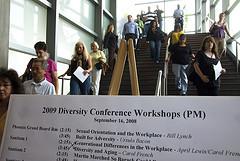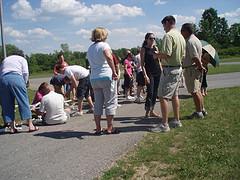 It has guidelines and contribute to the integration of activities and visions, helping to accommodate the diversity inherent in any organization, but at the same time valuing and recognizing the experience, authority, capacity and expertise of each and, e) Learning is encouraged Collaborative, ie learning the skills of reasoning that allows people to understand, analyze, evaluate, synthesize and apply the information they handle, (Gairin, 2000). The implementation of these four axioms, the organization promotes the development of tangible activities: new ideas, innovations in programming, new management and supervisory methods and tools to change the way people perform their work and develop an enduring capacity exchange. Coinciding with the previous approach, says Diaz (2001) that organizational learning is strongly linked to organizational change, in this sense says that any change or modification due to the construction of new knowledge, culture, values, the members that make up an organization. In the same vein, Picon (1994) argues that organizational learning is related to: “Any changes to some extent the theory of action of the organization performing relatively persistent” (p. 55). Understanding that the theory of action has to do with thought-action relationship and in this sense, sees man as a being who designs his actions, implements and evaluates its consequences when adopting their designs meet their intentions consequences and modify or try to change them when you are adverse outcomes. Only if the theory of action of the organization is changed in any of its components, you can mention that the organization has learned.
It has guidelines and contribute to the integration of activities and visions, helping to accommodate the diversity inherent in any organization, but at the same time valuing and recognizing the experience, authority, capacity and expertise of each and, e) Learning is encouraged Collaborative, ie learning the skills of reasoning that allows people to understand, analyze, evaluate, synthesize and apply the information they handle, (Gairin, 2000). The implementation of these four axioms, the organization promotes the development of tangible activities: new ideas, innovations in programming, new management and supervisory methods and tools to change the way people perform their work and develop an enduring capacity exchange. Coinciding with the previous approach, says Diaz (2001) that organizational learning is strongly linked to organizational change, in this sense says that any change or modification due to the construction of new knowledge, culture, values, the members that make up an organization. In the same vein, Picon (1994) argues that organizational learning is related to: “Any changes to some extent the theory of action of the organization performing relatively persistent” (p. 55). Understanding that the theory of action has to do with thought-action relationship and in this sense, sees man as a being who designs his actions, implements and evaluates its consequences when adopting their designs meet their intentions consequences and modify or try to change them when you are adverse outcomes. Only if the theory of action of the organization is changed in any of its components, you can mention that the organization has learned.
Teamwork
 In other words, a fad, something that people in organizations seem to use, but often not used. This is one of the reasons for the failure of many initiatives in enterprises. To introduce something without considering that it is feasible to generate rejection by cultural differences and, therefore, without providing the necessary actions to reduce the level of rejection. Teamwork is a management method, and if understood as such, with the difficulties and the advantages, can be a substantive tool for continuous quality improvement. The contribution of teamwork is key to improving the internal and external quality as long as properly defining the limits and scope about what we mean by quality and equipment, and how to achieve Analy Meneses reminds us, the importance of having good clear the difference between what is teamwork and teamwork., so teamwork is more related to the procedures, techniques and strategies used by a particular group of people to achieve their goals. While the task force, involving a group of people with skills and functions to be developed for the fulfillment of ultimate goals.
In other words, a fad, something that people in organizations seem to use, but often not used. This is one of the reasons for the failure of many initiatives in enterprises. To introduce something without considering that it is feasible to generate rejection by cultural differences and, therefore, without providing the necessary actions to reduce the level of rejection. Teamwork is a management method, and if understood as such, with the difficulties and the advantages, can be a substantive tool for continuous quality improvement. The contribution of teamwork is key to improving the internal and external quality as long as properly defining the limits and scope about what we mean by quality and equipment, and how to achieve Analy Meneses reminds us, the importance of having good clear the difference between what is teamwork and teamwork., so teamwork is more related to the procedures, techniques and strategies used by a particular group of people to achieve their goals. While the task force, involving a group of people with skills and functions to be developed for the fulfillment of ultimate goals.
Aulafacil.com tells us further that teamwork involves a group of people working in coordination in the implementation of a project. The team answered the final result and not every one of its members independently. Each member specializes in a particular area that affects the project. Each team member is responsible for a task and only if they all perform their function will be possible to take the project forward are also reminds us that will be remembered, that teamwork is based on the "5 c": Complementarity: each Member dominates a given parcel of the project.
Organizational Learning
 Finally, the author raises, which Organizational Learning everything happens first as a learning process, and then integrated into a gestalt of the group. For its part Senge (1992), led to a theory of Organizational Learning, by relating the current humanistic management, general systems theory and information theory. He defines learning organizations as a social activity where knowledge and skills are implemented, they are criticized and are integrated as opportunities to optimize learning and effectiveness in the workplace. At the same time raises, that the learning organization people can not stop learning because learning is part of the fabric of everyday life.
Finally, the author raises, which Organizational Learning everything happens first as a learning process, and then integrated into a gestalt of the group. For its part Senge (1992), led to a theory of Organizational Learning, by relating the current humanistic management, general systems theory and information theory. He defines learning organizations as a social activity where knowledge and skills are implemented, they are criticized and are integrated as opportunities to optimize learning and effectiveness in the workplace. At the same time raises, that the learning organization people can not stop learning because learning is part of the fabric of everyday life.
In the learning organization, people enhance their ability to create what they want to create and have an ingrained philosophy for anticipating, reacting, and responding to change, complexity and uncertainty. In this way it is interpreted that the proportion to the speed at which organizations learn may become a sustainable source of competitive advantage. It raised before we can say that learning organizations are those that facilitate the learning of all its members and to continually transform to meet the demands of the environment. The key is to understand the learning as inseparable from everyday work to create spaces in which to address the problems, clarify differences, creating a sense of belonging, ownership of goals and institutional objectives. Senge (2000), focuses the study of organizational learning, in terms of its ontological dimension, at the organizational level, transcending the individual and the group. This article highlights his view of learning in organizations in a systemic perspective, considering that the key to an organization to learn, lies in the overall understanding of it and the interactions among its parts.
The Importance Of Management Skills
 In the specific case of the companies we are concerned, these actors need reliable than those involving skills to operate, produce efficiently, ensuring not only survival but development, achievement and permanence of the market. What really are the skills? What is involved? Why its importance, scope, impact? It is true that states that a company decides to accept work for Powers, must work systematically to identify the competencies required by their staff, since it is almost impossible to make use of skill sets developed by other organizations. Although you can make use of the lists of generic competencies developed by different authors, the organization released no additional work to adapt and disseminate among staff, because in fact, is creating a new way of perceiving the work itself .
In the specific case of the companies we are concerned, these actors need reliable than those involving skills to operate, produce efficiently, ensuring not only survival but development, achievement and permanence of the market. What really are the skills? What is involved? Why its importance, scope, impact? It is true that states that a company decides to accept work for Powers, must work systematically to identify the competencies required by their staff, since it is almost impossible to make use of skill sets developed by other organizations. Although you can make use of the lists of generic competencies developed by different authors, the organization released no additional work to adapt and disseminate among staff, because in fact, is creating a new way of perceiving the work itself .
To determine its importance, relevance and scope, it is important to determine what is meant by responsibility in this regard is can point to some definitions that allow us to determine its scope, relevance, namely: To Boyatzis (Woodruffe, 1993) are “sets of patterns, a person must carry a charge to efficiently perform their duties and functions Ansorena Cao ( 1996): “A skill or personal attribute of the behavior of a subject, which can be defined as a characteristic of their behavior, and, under which the task-oriented behavior can be classified in a logical and reliable.” (p. 76 ) Guion (quoted in Spencer and Spencer) defined as underlying characteristics of people who suggest ways of behaving or thinking, generalize from one situation to another, and that are maintained over a reasonably long “Woodruffe (1993) are presented as “One dimension of open and gross behavior, which will allow a person to perform efficiently.” It follows as recorded by Nelson Rodriguez Trujillo: 1.